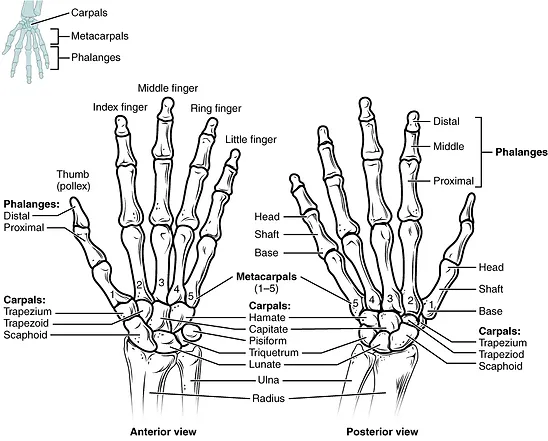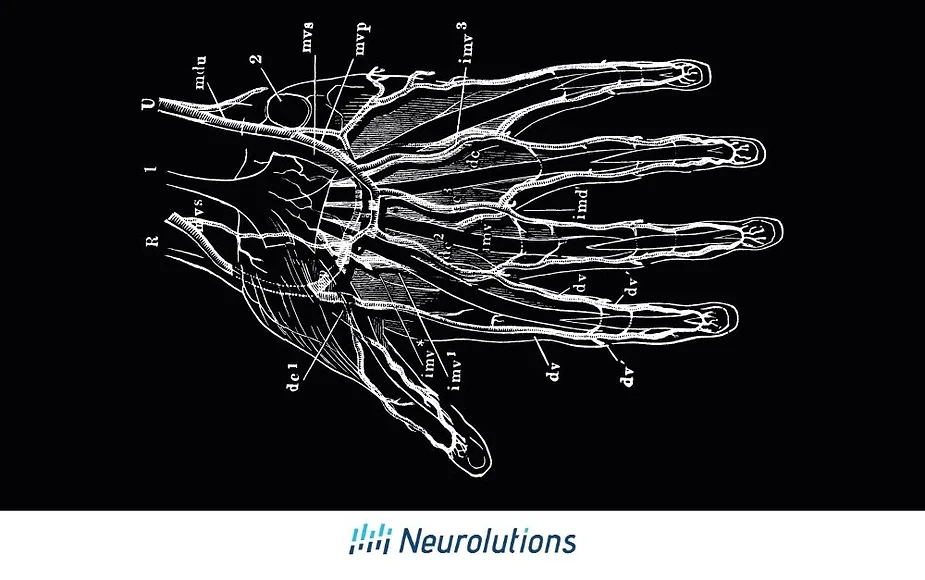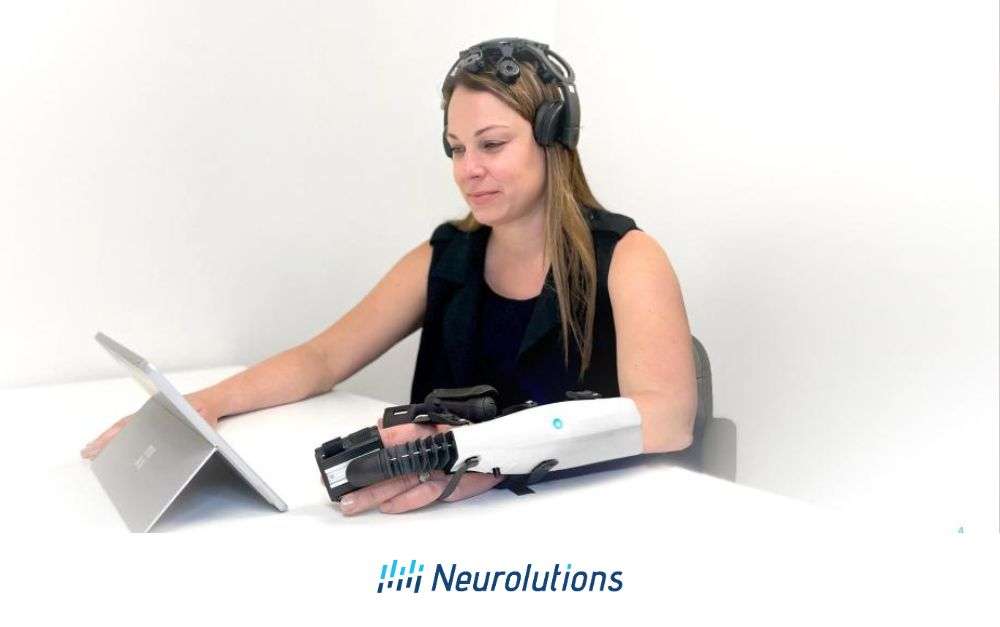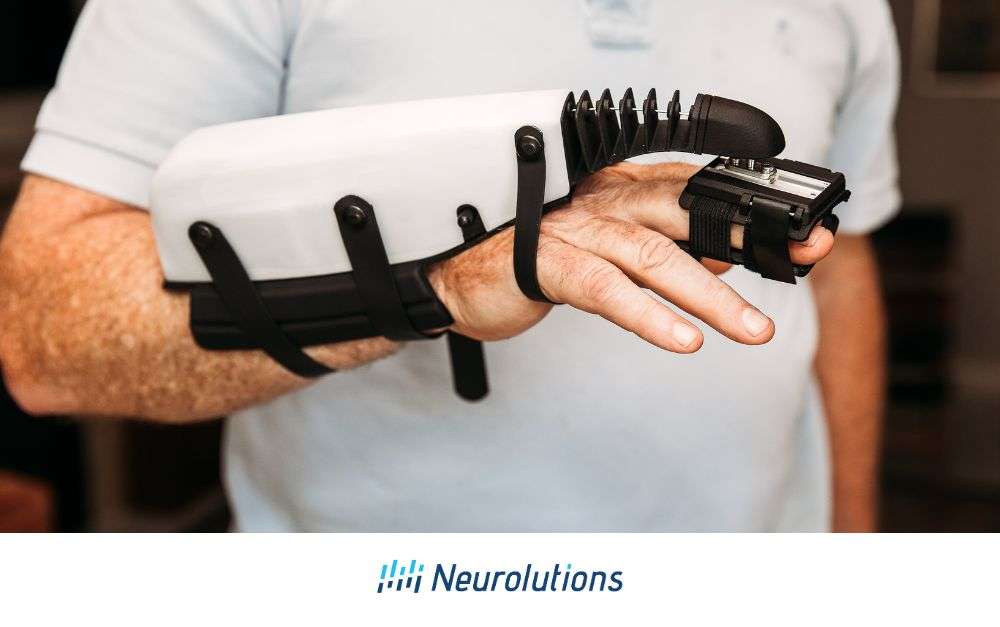Hand impairments following a stroke can impact activities of daily living, especially activities that involve reaching, grasping, and hand manipulation. However, specific fine motor exercises can be performed in order to restore hand strength and manipulation. Application of these fine motor exercises may positively impact daily, leisure, work, and self-care activities.
Anatomy of the Hand

OpenStax College, CC BY 3.0 <https://creativecommons.org/licenses/by/3.0>, via Wikimedia Commons
The hand consists of a highly integrated system of skeletal, soft tissue, nervous system, lymphatic, and cardiovascular structures. These structures work together to allow for proper function, movement, and sensation in this complex area of the body.
Skeletal Structure Of The Hand:
There are 29 bones in the hand and wrist, including the radius and ulna. The bones are dense structures that give support to the soft tissues of the hand. The joints in our hands serve as meeting points for bones to allow the hand and fingers to move like hinges.
Soft Tissue Structures Of The Hand: Ligaments, Muscles, And Tendons
Ligaments are the thick white “straps” of sturdy tissue that hold the joints together and allow for joint movement. Hand muscles and tendons are very important in fine motor control. Muscles are the red fleshy structures that contract and relax to move the joints of the hand and wrist. Ironically, the majority of hand and wrist movement is controlled by muscles located in the forearm, while there are smaller muscles in our hand that assist with grasping and hand-manipulation. Each muscle in our hands connects to a tendon, which are white cord-like structures There are many tendons running through the wrist and into each finger to help with finger manipulation and isolation (2).
Cardiovascular Structures Of The Hand:
The hand and wrist are supplied with blood by a network of arteries and veins. The main arteries in the hand are the radial artery, which runs along the thumb side of the wrist, and the ulnar artery, which runs along the pinky side of the wrist. These arteries branch out to supply various areas of the hand with oxygenated blood. The veins return the deoxygenated blood back to the heart.
Nervous System Networks Of The Hand:
Each nerve in the hand plays a crucial role in performing activities of daily living. The nerves in the hand and wrist are responsible for providing sensation and controlling the muscles, which are essential for carrying out various tasks and movements.
The major nerves that pass through the hand and wrist are the median nerve, the radial nerve, and the ulnar nerve. These nerves are responsible for providing sensation (e.g. temperature, vibration, touch, and pain) (2). Nerves also play a role in sending signals from the brain down the spine to influence movement and motor skills in the hand.
The signals sent by the nerves innervating the hands are responsible for the sense of touch and allowing recognition of various sensations. This ability to feel and interpret sensations is known as somatosensation. It is crucial for daily interactions with the environment and plays a significant role in ensuring safety and well-being.
Why a Basic Understanding of Hand Structure and Function Matters in Stroke Rehabilitation
Understanding and familiarizing oneself with the components of the hand and their functions become even more critical in the context of stroke or any other condition that may lead to impairments. Strokes can have a significant impact on the brain, affecting various parts of the body, including the hands. Depending on the location and severity of the stroke, it can lead to impairments in motor skills, sensation, and coordination, making it challenging to perform activities of daily living.
Here are some ways a stroke can affect the hand and hinder daily activities:
- Hemiparesis or Hemiplegia
Hemiparesis refers to weakness on one side of the body, while hemiplegia indicates paralysis on one side. A stroke affecting the motor regions of the brain can lead to weakness or paralysis of the muscles on the opposite side of the body from the affected brain hemisphere. This often means that the hand and arm on one side of the body may be significantly weakened or nonfunctional. - Motor Impairments
Strokes can result in weakness or paralysis of the muscles in the hand, making it difficult to grasp, grip, and manipulate objects. This can significantly impact tasks such as dressing, eating, writing, and personal hygiene. - Sensory Changes
Stroke-related damage to the sensory pathways can lead to altered or decreased sensation in the hand. Individuals may have difficulty sensing temperature, texture, and pain, increasing the risk of injury while handling objects. - Coordination and Dexterity
Stroke can disrupt the fine motor control of the hand, affecting activities that require precise movements, such as buttoning shirts, using utensils, and typing on a keyboard. - Spasticity
Some stroke survivors may experience spasticity, a condition characterized by stiff and involuntary muscle contractions. This can interfere with the ability to open and close the hand smoothly. - Cognitive and Perceptual Challenges
Stroke can also impact cognitive functions, such as attention and memory, which are essential for carrying out complex tasks involving the hands. Apraxia is an impairment following a stroke with refers to lack of “motor planning”, Motor planning is how our brain tells the hand to move. Sometimes the hand appears as weak when really apraxia is the limiting factor of functional use.
Causes of Hand Impairments from a Stroke
It is important to remember that strokes are a result of an insult to the brain and not in the hand itself. After a stroke, there is a disruption of blood flow and nerve signals to multiple parts of the body, including our hands. The disruption of the connections causes hand impairments, preventing our hands from functioning properly. The damage to the brain blocks these connections from reaching our hands as a result of the stroke.
Various brain regions play a role in controlling hand function, and a stroke can affect any of these areas, leading to different types of motor and sensory deficits in the hand.
Some of the key brain regions involved in hand function include:
- Primary Motor Cortex
Located in the frontal lobe of the brain, the primary motor cortex is responsible for initiating and executing voluntary movements. Strokes affecting this area can lead to weakness or paralysis on the opposite side of the body, including the hand. - Somatosensory Cortex
The somatosensory cortex, situated in the parietal lobe, processes sensory information from the skin and muscles, allowing us to perceive touch, temperature, and proprioception (awareness of body position). Stroke-related damage to this region can result in sensory deficits in the hand, such as reduced ability to feel touch or temperature changes. - Cerebellum
The cerebellum is vital for fine motor coordination, rapid movement, and precision. (3) Strokes affecting the cerebellum can lead to coordination difficulties, impacting activities that require fine hand movements and dexterity. Examples include difficulty writing, sorting coins in the hand, playing a video game, or stocking a shelf. Damage to the cerebellum due to conditions from a stroke may cause a condition called cerebellar ataxia. Individuals with cerebellar ataxia may experience problems with coordination, balance, and fine motor skills, making it challenging to perform everyday tasks smoothly. - Basal Ganglia
The basal ganglia are involved in regulating movement and muscle tone. Damage to this area due to a stroke can result in motor control issues and involuntary movements. - Brainstem
The brainstem is responsible for regulating many essential functions, including some aspects of hand function. Strokes affecting the brainstem can lead to a range of motor and sensory deficits in the hand.
Benefits for Fine Motor Exercises
Fine motor skills play a crucial role in our life. We are constantly using our hands to perform daily, leisure, play, educational, and even work activities. When we are using our hands, we are exploring our world. We are feeling everything around us. Think about how often you use your hands everyday. Given the significant role our hands play in our daily activities, it’s crucial to maintain a routine of fine motor exercises.
If you or your loved one have experienced a stroke and there are known movement and sensory challenges of the hand. Performing fine motor exercises may improve wrist, hand and finger range of motion, strength and dexterity, hand-manipulation, finger isolation, sensation, hand-eye coordination, and daily living skills.
Types of Fine Motor Exercises
There are many fine motor exercises you can perform, even at home, to improve your fine motor skills. Some exercises and activities can include:
- Finger tapping
- Grasping and releasing
- Hand squeezing
- Writing and drawing
- Hand therapy tools:
- Theraputty
- Stress ball
- Gripper
- Peg Board
- Flexbar
|| Learn More About Hand Exercises You Can Do At Home
Some activities that you can perform at home to maximize your fine motor skills may include (5):
- Watering plants with a spray bottle
- Cutting paper with a pair of scissors
- Buttoning a shirt
- Tying shoes
- Opening cans
- Peeling an orange
- Screw and unscrew nuts and bolts
- Placing coins in a piggy bank
- Using clothes pins
- Puzzles
There are numerous therapy treatments you can combine while performing your fine motor activities to promote the best results.
Some of these treatments include occupational therapy, physical therapy, neuromuscular electrical stimulation (NMES), dry needling, mirror therapy, and Botox treatment.
Individualizing Your Own Plan
There are different levels of hand exercises that can be performed. Ensure “just-right” exercises are selected to help you in your stroke recovery journey. The concept of “just-right” involves striking a balance where the activities are neither overly challenging to the point of being unachievable nor excessively easy to the extent of lacking benefits. This allows you to achieve your goals appropriately.
It is important to incorporate these exercises into your own individualized rehab protocol. Every stroke is different. Every stroke recovery is different. The specific location of the stroke within the brain will dictate the stroke recovery plan tailored to your needs.
In addition, everyone is on different levels within their recovery plan. You might be starting at the beginning phase of hand exercises while someone else is performing more intense exercises. Try to not be discouraged or embarrassed for starting at the beginning level. All that matters is that you started at your pace, your level, and you can get through this battle.
Whether you receive therapy outpatient, inpatient, or home care, your therapist or specialist will provide exercises to perform at home. These exercises can include stretching, range of motion, and strengthening activities. It is important to stay on task and listen to your therapist, if you want to maximize the results. Some therapists may want you to perform the exercises everyday while others will have you practice every other day. Regardless, it is important to not over-perform, as that may cause some setbacks. If you feel intense pain or soreness while performing your exercises, stop. Reevaluate your plan with your therapist and care partner. Remember that these activities are here to help you, not harm you. If you feel as though you can only perform 10 reps of an exercise instead of 15 reps, that is okay! Go at your own pace and monitor your body.
Always keep in mind you are not alone. If you have questions or feel as though your rehab plan is not working, talk to your doctor and care-partner. They are there to help you through your journey. Always advocate for yourself.
References
- Improving fine motor skills. www.stroke.org. Accessed August 18, 2023. https://www.stroke.org/en/about-stroke/effects-of-stroke/physical-effects-of-stroke/physical-impact/improving-fine-motor-skills
- Basic hand and wrist anatomy mount pleasant, sc. Hand Institute of Charleston. Accessed August 18, 2023. https://www.handinstituteofcharleston.com/additional-conditions-we-treat/basic-hand-and-wrist-anatomy
- American association of neurological surgeons. Accessed August 18, 2023. https://www.aans.org/
- Waxman SG. Somatosensory systems. In: Clinical Neuroanatomy. 28th ed. McGraw-Hill Education; 2017. Accessed August 18, 2023. accessmedicine.mhmedical.com/content.aspx?aid=1137638411
- Hand exercises for stroke patients of all ability levels. Flint Rehab. Published December 13, 2022. Accessed August 18, 2023. https://www.flintrehab.com/hand-exercises-for-stroke-patients/
- Hand Exercises & Activities for Stroke Recovery. Accessed August 18, 2023. https://www.youtube.com/watch?v=8xbh1lcUiiY




